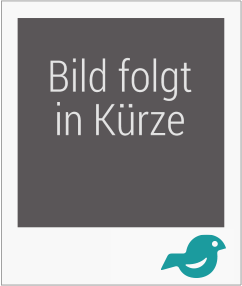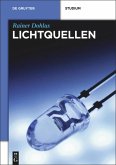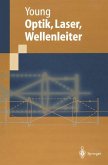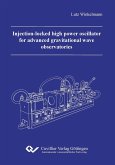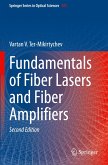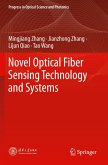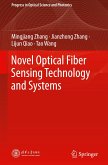Optical Fiber Lasers
Recent Advances and Applications
Herausgegeben:Ferreira S., Mário; Paul, Mukul Chandra
Optical Fiber Lasers
Recent Advances and Applications
Herausgegeben:Ferreira S., Mário; Paul, Mukul Chandra
- Gebundenes Buch
- Merkliste
- Auf die Merkliste
- Bewerten Bewerten
- Teilen
- Produkt teilen
- Produkterinnerung
- Produkterinnerung
This book provides a comprehensive overview of the latest achievements in the field of optical fiber lasers, covering the basics, technology, and numerous applications. Optical fiber lasers are key in a variety of scientific, military, medical, industrial, and commercial spheres, and therefore have undergone rapid innovation. Each chapter highlights a novel development in refining fiber laser features such as the output lasing wavelength, output power, nature of the laser beam, nature of the output laser pulse, design of lasing cavity, and design of fiber structure. These improvements are then…mehr
Andere Kunden interessierten sich auch für
![Fiber Optic Interferometer Fiber Optic Interferometer]() Yanbiao LiaoFiber Optic Interferometer129,99 €
Yanbiao LiaoFiber Optic Interferometer129,99 €![Lichtquellen Lichtquellen]() Rainer DohlusLichtquellen39,95 €
Rainer DohlusLichtquellen39,95 €![Optik, Laser, Wellenleiter Optik, Laser, Wellenleiter]() Matt YoungOptik, Laser, Wellenleiter49,99 €
Matt YoungOptik, Laser, Wellenleiter49,99 €![Injection-locked high power oscillator for advanced gravitational wave observatories Injection-locked high power oscillator for advanced gravitational wave observatories]() Lutz WinkelmannInjection-locked high power oscillator for advanced gravitational wave observatories31,83 €
Lutz WinkelmannInjection-locked high power oscillator for advanced gravitational wave observatories31,83 €![Fundamentals of Fiber Lasers and Fiber Amplifiers Fundamentals of Fiber Lasers and Fiber Amplifiers]() Vartan V. Ter-MikirtychevFundamentals of Fiber Lasers and Fiber Amplifiers136,99 €
Vartan V. Ter-MikirtychevFundamentals of Fiber Lasers and Fiber Amplifiers136,99 €![Novel Optical Fiber Sensing Technology and Systems Novel Optical Fiber Sensing Technology and Systems]() Mingjiang ZhangNovel Optical Fiber Sensing Technology and Systems83,99 €
Mingjiang ZhangNovel Optical Fiber Sensing Technology and Systems83,99 €![Novel Optical Fiber Sensing Technology and Systems Novel Optical Fiber Sensing Technology and Systems]() Mingjiang ZhangNovel Optical Fiber Sensing Technology and Systems113,99 €
Mingjiang ZhangNovel Optical Fiber Sensing Technology and Systems113,99 €-
-
-
This book provides a comprehensive overview of the latest achievements in the field of optical fiber lasers, covering the basics, technology, and numerous applications. Optical fiber lasers are key in a variety of scientific, military, medical, industrial, and commercial spheres, and therefore have undergone rapid innovation. Each chapter highlights a novel development in refining fiber laser features such as the output lasing wavelength, output power, nature of the laser beam, nature of the output laser pulse, design of lasing cavity, and design of fiber structure. These improvements are then applied to a wide variety of lasers, including Raman fiber lasers, gas-filled fiber lasers, rare-earth doped fiber lasers, and more. This book also sheds light on the rise in AI-enabled fiber laser systems in industrial manufacturing. The in-depth coverage of the latest developments in various kinds of optical fiber laser technology ensure this volume will serve as a valuable resource for graduate students, engineers, and scientists both experienced and new to the field.
Produktdetails
- Produktdetails
- Springer Series in Optical Sciences 250
- Verlag: Springer / Springer Nature Switzerland / Springer, Berlin
- Artikelnr. des Verlages: 89281809, 978-3-032-04109-8
- Seitenzahl: 544
- Erscheinungstermin: 6. April 2026
- Englisch
- Abmessung: 235mm x 155mm
- ISBN-13: 9783032041098
- ISBN-10: 3032041090
- Artikelnr.: 74989209
- Herstellerkennzeichnung
- Springer-Verlag GmbH
- Tiergartenstr. 17
- 69121 Heidelberg
- ProductSafety@springernature.com
- Springer Series in Optical Sciences 250
- Verlag: Springer / Springer Nature Switzerland / Springer, Berlin
- Artikelnr. des Verlages: 89281809, 978-3-032-04109-8
- Seitenzahl: 544
- Erscheinungstermin: 6. April 2026
- Englisch
- Abmessung: 235mm x 155mm
- ISBN-13: 9783032041098
- ISBN-10: 3032041090
- Artikelnr.: 74989209
- Herstellerkennzeichnung
- Springer-Verlag GmbH
- Tiergartenstr. 17
- 69121 Heidelberg
- ProductSafety@springernature.com
Mário F. S. Ferreira is a Professor at the Physics Department of Aveiro University, Portugal. Between 1990 and 1991 he was at the University of Essex, UK, performing experimental work on external cavity semiconductor lasers and nonlinear optical fiber amplifiers. His research interests have been concerned with the modelling and characterization of multi-section semiconductor lasers for coherent systems, quantum well lasers, optical fiber amplifiers and lasers, optical sensors, soliton propagation, polarization and nonlinear effects in optical fibers. He has been the leader of the Optics and Optoelectronics Group of the I3N – Institute of Nanostructures, Nanomodelling and Nanofabrication. He has written about 400 scientific journal and conference publications, and several books, namely: “Optics and Photonics” (Lidel, 2003, in Portuguese), “Topics of Mathematical Physics” (Editora Ciência Moderna, 2018, Brazil, in Portuguese), “Optical Fibers: Technology, Communications and recent Advances” (Ed., NOVA Science Publishers, 2017), “Advances in Optoelectronic Technology and Industry Development” (CRC Press, 2019), “Nonlinear Effects in Optical Fibers” (John Wiley & Sons, OSA, 2011), “Optical Signal Processing in Highly Nonlinear Fibers” (CRC Press, 2020), “Optical Fiber Technology and Applications – Recent Advances” (IOP Publishing, 2021), “ Solitons in Optical Fiber Systems” (John Wiley & Sons, 2022), “Dissipative Optical Solitons” (Springer, 2022), “Photonic Crystal Fibers - Recent Advances” NOVA Science Publishers, 2023, “Specialty Optical Fibers - Materials, Fabrication Technology and Applications” (Elsevier, 2024), and “ Lasers Optics and Photonics” (In Press, Oxford University Press, 2025). He was the Guest Editor of four Special Issues of “Fiber and Integrated Optics ” (Taylor & Francis): “Fiber Optics in Portugal” (2005), “Nonlinear Fiber Optics” (2015), “Optical Fiber Sources and Amplifiers” (2020) and “Quantum Communications” (2020), a joint Special Issue of “Optics Express” and “ Applied Optics” (OSA) on “Optical Sensors and Sensing 2019”, one Special Issue of the “Journal of Nonlinear Mathematical Physics” (Springer) on “ Complex Ginzburg-Landau Equation”, and two Special Issues of “Fibers” (MDPI) on “Optical Fiber Communications” and “Specialty Optical Fibers – Material, Fabrication and Applications” (2022), and two Special Issues of “ Fibers” (MDPI) on “Optical Fiber Communications” (2020) and “ Characterization and Applications of Specialty Optical Fibers” (2025). He is a Fellow and a Travelling Lecturer of both OPTICA (Optical Society of America) and SPIE - The International Society for Optics and Photonics, and a Member of IEEE. He served in various committees of OSA/OPTICA and of SPIE, as well as in the organizing and scientific committees of various international conferences. Additionally, he serves as an Associate Editor or as an Advisor Board Member of several international journals in the area of optics and photonics. Dr. Mukul Chandra Paul received his Ph.D. degree from Jadavpur University, Kolkata, India in 2003. He is currently serving as Chief Scientist and Head of the Fiber Optics and Photonics Division as well as the Instrumentation and Information Technology Division (IITD) at the CSIR-Central Glass and Ceramic Research Institute (CGCRI), Kolkata, India. Dr. Paul has authored or co-authored more than 250 peer-reviewed journal and conference papers, along with 10 book chapters, and holds seven U.S. patents in the field of rare-earth doped specialty optical fibers. He has also edited three books focusing on fiber lasers and specialty optical fibers. His research has significantly advanced the field through international collaborations with institutions in Malaysia, China, Taiwan, the UK, France, Russia, Vietnam, Portugal, and others. Dr. Paul’s scientific achievements have been recognized with numerous prestigious awards, including: BOYSCAST Fellowship Award, DST, India (2006); MOSTI Award, Government of Malaysia (2010); IEEE Photonics Distinguished Lecture Award, Malaysia (2011); CSIR Technology Awards (2012 & 2015); DST-UKIERI Collaborative Research Award (2013); Indo-Russian (RFBR) Collaborative Research Grant (2016); Indo-Portugal (FCT) Collaborative Research Grant (2017); Senior Visiting Scientist Award, National Taiwan University of Technology (2020); CK Somany Award for Innovation and Technology, AIGMF (2020); Adjunct Professorship, Airlangga University, Indonesia (2021). He is a Senior Member of IEEE and the Optical Society of India (OSA), and a Life Member of the Materials Research Society of India (MRSI) and the Indian Ceramic Society. Dr. Paul also contributes to national standardization as a Technical Committee Member of the Chemical Divisional Council (CHD C) and the LITD 11 (Fiber Optics, Fibers, Cables and Devices Sectional Committee) under the Bureau of Indian Standards. Dr. Paul has supervised 6 Ph.D. scholars, guided 10 M.Sc. research projects, and served as Principal Investigator (PI) in 17 sponsored projects with funding exceeding ¿416 lakhs. Collectively, as PI/Co-PI/member, he has completed 34 projects with total funding of ¿46.0 crores. He has delivered over 50 invited talks at national and international platforms and served as Guest Editor or Editor for several high-impact journals and books. Notable editorial contributions include: Guest Editor, IEEE JSTQE, Special Issue on Fiber Lasers (2014); Guest Editor, Current Nano Science, Special Issue on Nano-engineered Optical Fibers (2015); Editor, Fiber Laser, InTech (2016); Editor, Fiber Laser: Advances in Research and Applications, Nova Science (2017); Guest Editor, Optical Materials Express (2019); Associate Editor, IEEE Photonics Journal, Special Issue on Specialty Optical Fibers (2019); Editor, Optical Fiber Technology and Applications, IOP Publishing, UK (2020); Guest Editor, Fiber and Integrated Optics, Taylor and Francis (2020); Editor, Specialty Optical Fibers: Materials, Fabrication Technology and Applications, Elsevier (2024). His current research interests focus on the development of specialty optical fibers with advanced material compositions for continuous-wave and pulsed fiber lasers, high-power amplifiers, fiber-based saturable absorbers, and broadband supercontinuum sources, often through industry-academia collaborations.
Chapter 1: Introduction: Optical Fiber Lasers.- Chapter 2: Q-Switched Erbium-Doped Fiber Lasers.- Chapter 3: Dissipative Solitons in Passively Mode-Locked Lasers.- Chapter 4: Ultra-Short High Amplitude Dissipative Solitons in Fiber Lasers.- Chapter 5: Multiplexed Dissipative Soliton Fiber Lasers.- Chapter 6: All-polarization maintaining thulium-doped passively mode-locked fiber lasers.- Chapter 7: Ultrafast Raman Fiber Lasers.- Chapter 8: Gas-Filled Hollow Core Fiber Lasers.- Chapter 9: Distributed feedback fiber laser based on regular and random RI structures..- Chapter 10: Random Fiber Lasers (RFLs): conception, demonstration and exploration.- Chapter 11: Self-Sweeping Fiber Laser.- Chapter 12: Wavelength-tunable mode-locked polarization-maintaining fiber laser.- Chapter 13: Nonlinear frequency conversion of fiber laser.- Chapter 14: Development of pulse fiber laser based on 2D materials.- Chapter 15: Large Mode Area Fibers for High Power Lasers.- Chapter 16: High power narrow linewidth linearly polarized fiber laser.- Chapter 17: Multielements doped silica glass-based specialty optical fibers for high power optical laser and optical amplifiers.- Chapter 18: The journey, current status, and challenges of high-power fiber laser spectral beam combining technology.- Chapter 19: High-power fiber laser in the AI era.- Chapter 20: Advancement in plasmonic fiber random lasers.
Chapter 1: Introduction: Optical Fiber Lasers.- Chapter 2: Q-Switched Erbium-Doped Fiber Lasers.- Chapter 3: Dissipative Solitons in Passively Mode-Locked Lasers.- Chapter 4: Ultra-Short High Amplitude Dissipative Solitons in Fiber Lasers.- Chapter 5: Multiplexed Dissipative Soliton Fiber Lasers.- Chapter 6: All-polarization maintaining thulium-doped passively mode-locked fiber lasers.- Chapter 7: Ultrafast Raman Fiber Lasers.- Chapter 8: Gas-Filled Hollow Core Fiber Lasers.- Chapter 9: Distributed feedback fiber laser based on regular and random RI structures..- Chapter 10: Random Fiber Lasers (RFLs): conception, demonstration and exploration.- Chapter 11: Self-Sweeping Fiber Laser.- Chapter 12: Wavelength-tunable mode-locked polarization-maintaining fiber laser.- Chapter 13: Nonlinear frequency conversion of fiber laser.- Chapter 14: Development of pulse fiber laser based on 2D materials.- Chapter 15: Large Mode Area Fibers for High Power Lasers.- Chapter 16: High power narrow linewidth linearly polarized fiber laser.- Chapter 17: Multielements doped silica glass-based specialty optical fibers for high power optical laser and optical amplifiers.- Chapter 18: The journey, current status, and challenges of high-power fiber laser spectral beam combining technology.- Chapter 19: High-power fiber laser in the AI era.- Chapter 20: Advancement in plasmonic fiber random lasers.

